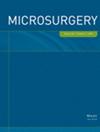With a global trend towards cesarean deliveries and abdominal surgeries for gastrointestinal disease treatment, more and more candidates for breast reconstruction using free deep inferior epigastric artery (DIEP) flap presented with abdominal scars. The purpose of the study was to investigate the risk of scar-related perfusion complications in DIEP flaps in patients with different abdominal scars.
A retrospective study was conducted in patients receiving DIEP flaps for breast reconstruction between October 2008 and April 2022. Demographics and the existing abdominal scars were collected. Acute and late complications were reviewed.
273 breasts in 267 patients were included. Abdominal scars presented in 96 (36.0%) patients, including transverse cesarean sectioning in 69, midline scars in eight, laparoscopic scars in 23, appendectomy scars in five, abdominal total hysterectomy in one, and umbilicus scar in one patient. They did not increase the conversion rate from DIEP to ms-TRAM flap. The flap sizes were significantly bigger in the scar (SG) than in the control group (CG) (flap length SG: 29.8 ± 3.0 cm, CG: 28.9 ± 3.0 cm, p = 0.021 and flap width SG: 11.9 ± 1.1 cm, CG: 11.6 ± 0.9 cm, p = 0.002, respectively). However, the flap used percentage was similar (SG: 72.9% ± 13.1% and CG: 75.7% ± 12.2%, respectively, p = 0.086). The SIEV could be identified bilaterally significantly more often in the CG than in the SG (SG: 80.2% and CG: 91.8%, p = 0.006). The availability of SIEV was significantly less when a transverse scar was present. The need for venous superdrainage with SIEV was not statistically different in both groups (SG: 8.3% and CG: 12.3%, p = 0.320). The overall re-exploration rate was 6.2%. Acute re-explorations (SG: 5.1% vs. CG: 6.9%) or late revisions for aesthetics (SG: 17.7% vs. CG: 21.8%) were equally distributed. Flap-related complications like partial necrosis or fat necrosis showed similar rates, regardless of SIEV use for superdrainage (p = 0.287). Lastly, acute donor site complications, especially poor wound healing, occurred similarly in both groups (p = 0.234).
Pre-existing abdominal scars do not compromise DIEP flap transfer, nor increase the incidence of late fat necrosis.


